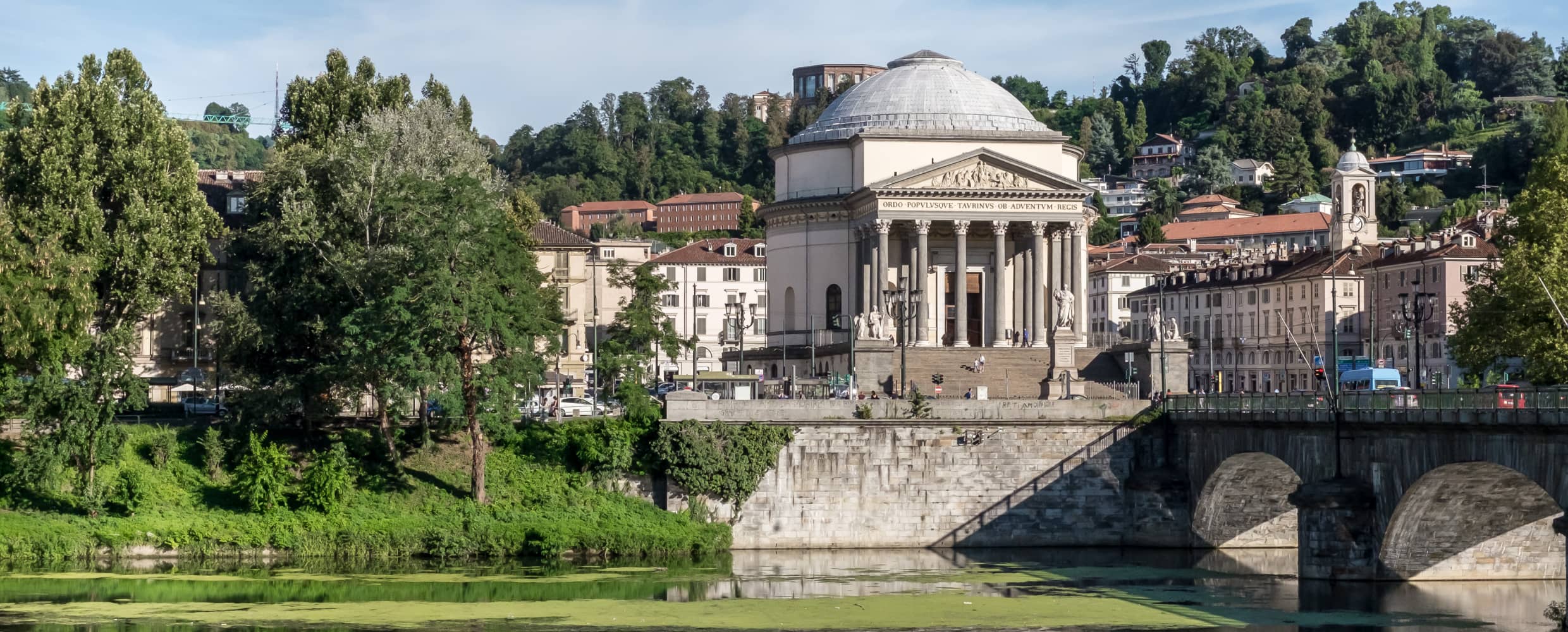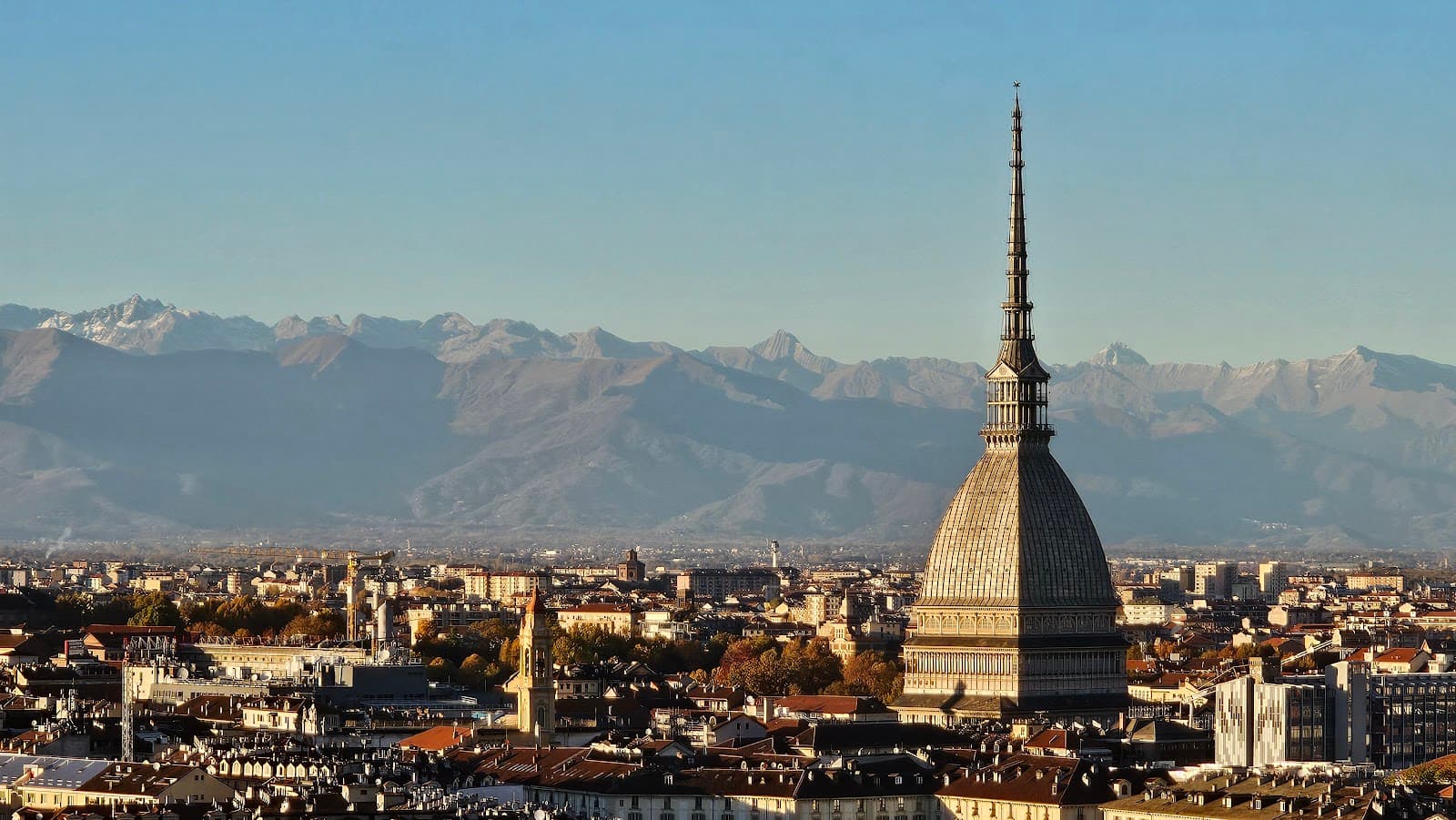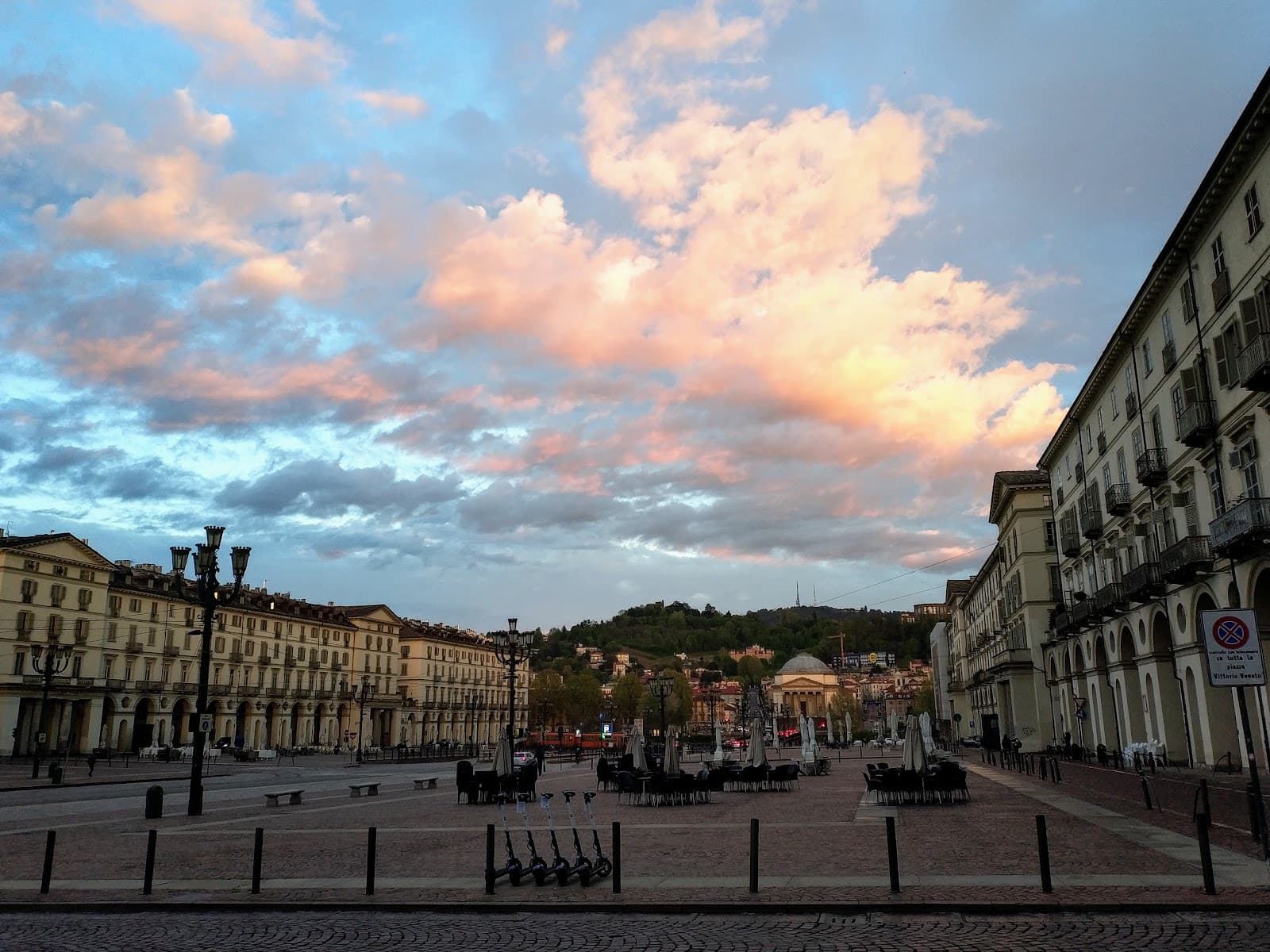
Gran Madre di Dio Turin
A grand Neoclassical church inspired by the Pantheon, offering stunning views and steeped in Turin's history and folklore.

Highlights
Must-see attractions

Social
From TikTok & Reddit
Best Time
Best views and photos

Gran Madre di Dio Turin
Best Time
Best views and photos

Highlights
Must-see attractions
A grand Neoclassical church inspired by the Pantheon, offering stunning views and steeped in Turin's history and folklore.
"Beautiful on the outside, not so much on the inside. The view of Via Po from the top of the steps is spectacular."
📸 Capture the View
The view from the steps overlooking Piazza Vittorio Veneto is a must-capture moment. :camerawithflash:
🏛️ Architectural Inspiration
Notice the clear inspiration from Rome's Pantheon in its design. A true neoclassical gem. :classical_building:
Highlights
Discover the most iconic attractions and experiences
Neoclassical Architecture
Exterior
Inspired by the Pantheon, this grand church boasts impressive Corinthian columns and a striking dome.
Piazza Vittorio Veneto View
Top of the steps
Enjoy a spectacular panoramic view of Piazza Vittorio Veneto and the Po River from the church's grand staircase.
Allegorical Sculptures
Base of the staircase
Admire the imposing statues of Faith and Religion, often mistaken for Marian figures, sculpted by Carlo Chelli.
Plans like a pro.
Thinks like you
Planning Your Visit
Timing Your Visit
Understanding the Legends
Best Times
Insider Tips
from TikTok, Instagram & Reddit
What to do in Torino
📸 Capture the View
The view from the steps overlooking Piazza Vittorio Veneto is a must-capture moment. :camerawithflash:
🏛️ Architectural Inspiration
Notice the clear inspiration from Rome's Pantheon in its design. A true neoclassical gem. :classical_building:
Due giorni a Torino: quali sono le cose da non perdere?
Top 5 things to see and do in Torino
🚶♀️ Explore the Piazza
Combine your visit with a stroll through Piazza Vittorio Veneto, one of Turin's largest squares. :walking:
🧐 Uncover the Legends
Learn about the local folklore surrounding the church, adding a layer of mystery to your visit. :scroll:
Tips
from all over the internet
📸 Capture the View
The view from the steps overlooking Piazza Vittorio Veneto is a must-capture moment. :camerawithflash:
🏛️ Architectural Inspiration
Notice the clear inspiration from Rome's Pantheon in its design. A true neoclassical gem. :classical_building:
🚶♀️ Explore the Piazza
Combine your visit with a stroll through Piazza Vittorio Veneto, one of Turin's largest squares. :walking:
🧐 Uncover the Legends
Learn about the local folklore surrounding the church, adding a layer of mystery to your visit. :scroll:
What Travellers Say
Reviews Summary
Visitors praise the Gran Madre di Dio for its stunning Neoclassical architecture and the breathtaking views it offers over Piazza Vittorio Veneto and the Po River. While some find the interior less remarkable than the exterior, its historical significance and prominent location make it a must-see landmark in Turin.
"The Church of the Gran Madre di Dio is located in the square of the same name on the right bank of the Po River, opposite Piazza Vittorio Veneto and the Vittorio Emanuele I Bridge. Designed by architect Ferdinando Bonsignore in neoclassical style, it is clearly inspired by the Pantheon in Rome, albeit on a smaller scale. Its construction, begun on July 23, 1818, with the laying of the cornerstone by Vittorio Emanuele I, was completed in 1831 during the reign of Carlo Felice, commissioned by the city government to celebrate the return of Vittorio Emanuele I after the fall of Napoleon. Indeed, on the tympanum of the pronaos is the epigraph: "Ordo populusque taurinus ob adventum regis," coined by Latinist Michele Provana del Sabbione, meaning "The nobility and people of Turin for the arrival (and, curiously, not "the return") of the king." After a decade-long interruption, construction resumed in 1827 under Charles Felix and was completed in 1831 under Charles Albert. The building sits on a high plinth, accessible via a dramatic staircase. The pronaos features six frontal and four lateral Corinthian columns, and the tympanum features a marble high relief from 1827, attributed to Francesco Somaini, depicting the Virgin and Child receiving homage from Turin's decurions. At the base of the staircase, on high plinths, two imposing allegorical figures, Faith and Religion, sculpted by Carlo Chelli, are often mistaken for Marian representations. At the foot of the staircase stands a colossal statue of Victor Emmanuel I, the work of Giuseppe Gaggini. Begun in 1849, it was completed in 1869 at the behest of Victor Emmanuel II and solemnly installed only in 1885. The church, which lacks a bell tower, has a freestanding bell tower built in 1830 near the oratory and parish offices. The interior, with a single nave and a circular plan, has an east-facing high altar, framed by red porphyry columns. Artist Andrea Galassi created the statue of the Great Mother of God with Child, surrounded by golden rays. The decoration at the base of the dome includes sculpted garlands and bas-reliefs depicting episodes from the life of the Virgin, based on models by Carlo Finelli. The most distinctive element is the dome itself, considered a masterpiece of Piedmontese neoclassicism. Characterized by five tiers of decreasing octagonal coffers, it is entirely made of concrete and culminates in an oculus over three meters in diameter, designed to illuminate the statue of St. John the Baptist, the city's patron saint, on June 24th. In the basement, a crypt designed by Giovanni Ricci houses the Shrine to the Fallen of the First World War, inaugurated in 1932 in the presence of Benito Mussolini. A curious fact: in the 19th century, the area in front of the churchyard was used to display the corpses of beggars and unknown persons awaiting identification. According to completely unfounded legends, the church was built on an ancient Egyptian temple dedicated to the goddess Isis, and the statue of Faith, holding a book and a chalice, represents the Madonna gazing at the place where the Holy Grail is kept. Folklore aside, the Gran Madre church is a monument of unquestionable historical and artistic value, representing the city's greatest example of neoclassical style and one of the very symbols of Turin."
Andrea
"The outside was covered in scaffolding, but that's necessary sometimes. The inside is very nice. Very clean and tidy."
Sjoerd Bouma
"Beautiful on the outside, not so much on the inside.
The view of Via Po from the top of the steps is spectacular."
Marco
What People Like
What People Dislike
Frequently Asked Questions
🚇 🗺️ Getting There
The Gran Madre di Dio is easily accessible by public transport. Several bus lines stop near Piazza Vittorio Veneto. It's also a pleasant walk across the Vittorio Emanuele I Bridge from the city center. :bus: :walking:
Parking in the immediate vicinity can be challenging due to its central location. Paid parking garages are available in the surrounding areas, but walking or using public transport is often more convenient. :car:
Absolutely! It's a scenic walk across the Vittorio Emanuele I Bridge, offering lovely views of the Po River and the Mole Antonelliana. The journey takes about 15-20 minutes from Piazza Castello. :bridgeatnight:
🎫 🎫 Tickets & Entry
Entry to the church itself is generally free, though donations are appreciated. However, specific areas or events might have separate ticketing. Always check official sources for any changes. :ticket:
The exterior is always accessible. Interior visiting hours can vary, so it's best to check the official church schedule or local tourist information for the most up-to-date times. :clock1:
Typically, there is no entrance fee to visit the main church area. It's a place of worship, and access is usually open to the public without charge. :moneywithwings:
The crypt, which houses the Shrine to the Fallen of the First World War, may have separate visiting hours or require specific access. Inquire locally for details on accessing this historical section. :military_medal:
📸 📸 Photography
Photography is usually permitted inside the church, but it's always respectful to check for any signage or ask church officials. Avoid using flash, especially during services. :iphone:
The grand staircase offers iconic shots with Piazza Vittorio Veneto in the background. The interior dome and altar are also photogenic. :camerawithflash:
Drone usage is generally restricted in urban areas and around historical monuments in Italy. It's highly unlikely to be permitted near Gran Madre di Dio without special authorization. :noentrysign:
🎫 🏛️ Onsite Experience
The church is a prime example of Neoclassical architecture, heavily inspired by the Pantheon in Rome. Its design features Corinthian columns, a grand pronaos, and a distinctive dome. :classical_building:
It was commissioned to celebrate the return of King Vittorio Emanuele I after Napoleon's fall. Its construction spanned several decades in the 19th century, making it a symbol of the era. :crown:
Yes, local folklore suggests it was built on an ancient Egyptian temple site and is linked to the Holy Grail. These legends add a layer of mystique to the site. :scroll:
Inside, you'll find a single nave, a high altar with columns, and a dome decorated with sculpted garlands and bas-reliefs depicting the life of the Virgin. The statue of the Great Mother of God with Child is a focal point. :statueofliberty:
The main church area is generally accessible, but the grand staircase leading up to it might pose a challenge. Inquire about specific accessibility options if needed. :wheelchair:
For Different Travelers
Tailored advice for your travel style
👨👩👧 Families with Kids
🏛️ History Buffs
Deep Dives
In-depth insights and expert knowledge
Architectural Marvel: Neoclassicism in Turin
The most distinctive feature is its dome, a masterpiece of Piedmontese neoclassicism. Constructed entirely of concrete, it is characterized by five tiers of decreasing octagonal coffers and culminates in an oculus. This architectural element not only provides natural light to the interior but also serves as a symbolic connection to the heavens. The interior, with its single nave and circular plan, houses an east-facing high altar framed by red porphyry columns. The statue of the Great Mother of God with Child by Andrea Galassi is a central artistic element, surrounded by golden rays. The dome's decoration includes sculpted garlands and bas-reliefs depicting episodes from the life of the Virgin, adding a rich narrative to the sacred space.
Beyond its religious function, the Gran Madre di Dio is a significant civic monument. Its location opposite Piazza Vittorio Veneto and the Vittorio Emanuele I Bridge makes it a focal point of the city's urban landscape. The allegorical figures of Faith and Religion at the base of the staircase, sculpted by Carlo Chelli, and the colossal statue of Victor Emmanuel I by Giuseppe Gaggini, further underscore its role as a symbol of national identity and historical commemoration. The church's design and placement contribute significantly to Turin's elegant and monumental cityscape.
Folklore and Legends: The Mystique of Gran Madre
Another popular legend connects the church to the Holy Grail. It's said that the statue of Faith, holding a book and a chalice, is actually the Madonna gazing towards the supposed location of the Holy Grail. This association with one of Christianity's most enduring mysteries draws many curious visitors. Turin itself has been a focal point for Holy Grail theories, and the Gran Madre di Dio's prominent position and symbolic imagery lend themselves well to these interpretations.
These legends, while not historically accurate, are an integral part of the Gran Madre di Dio's appeal. They transform the church from a mere architectural monument into a place of intrigue and mystery. Visitors often find themselves captivated by these stories, which add a unique dimension to their experience of exploring this significant Turin landmark.



Social
from TikTok, Instagram & Reddit